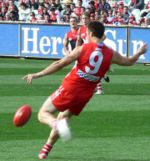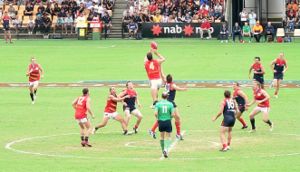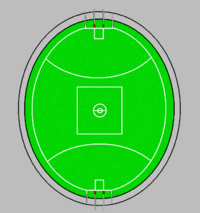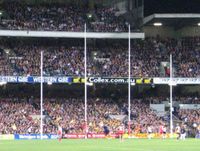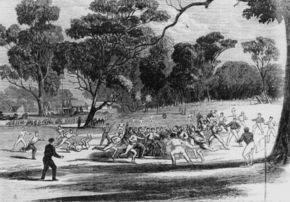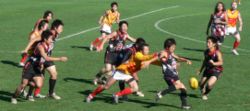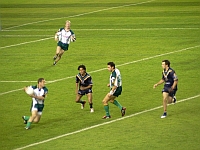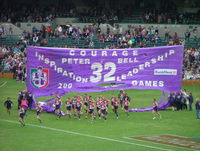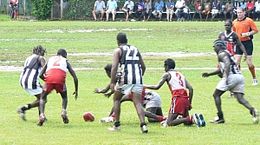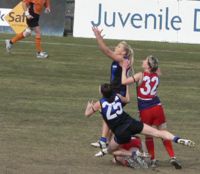Australian rules football
2007 Schools Wikipedia Selection. Related subjects: Sports
- Australian Rules and Aussie Rules redirect here.
- For the movie, see Australian Rules (film).
- For other codes of football played in Australia, see Football in Australia.
- For the movie, see Australian Rules (film).
Australian rules football, also known as Australian football, Aussie rules, or simply "football" or "footy", is a code of football played with an oblate spheroid ball, on large oval shaped fields, with four posts at each end. No more than 18 players of each team are permitted to be on the field at any time and the primary aim of the game is to score by kicking the ball between the posts. The winner is the team who has kicked the highest total score by the end of the match.
There are several different ways to advance the ball, including kicking and hand passing. When hand passing one hand must be used to hold the ball and the other to hit it — throwing the ball is not allowed. Players running with the ball must bounce or touch it on the ground. There is no offside rule and players can roam the field freely. Australian rules is a contact sport. Possession of the ball is in dispute at all times except when a free kick is paid. Players who hold on to the ball too long are penalised if they are tackled by an opposition player who is then rewarded, whilst players who catch a ball (known as a mark) from a kick exceeding 15 metres are awarded uncontested possession. The duration of play varies, but is longer than in any other code of football.
Frequent contests for possession including aerial marking or " speccies" and vigorous tackling with the hands, bumps and the fast movement of both players and the ball are the game's main attributes as a spectator sport.
The code originated in Melbourne, Australia in 1858, and was devised to keep cricketers fit during the winter months. The first laws of Australian football were published in 1859 by the Melbourne Football Club. The dominant governing body and most prestigious professional competition is the Australian Football League (AFL), which culminates in the annual AFL Grand Final, one of the biggest club championship events in the world.
Structure and competitions
The football season, proper, is from March to August (early autumn to late winter in Australia) with finals being held in September. In the tropics, the game is played in the wet season (October to March). Pre-season competitions in southern Australia usually begin in late February.
The most powerful organisation and competition within the game, the AFL, is recognised by the Australian Sports Commission as being the National Sporting Organisation for Australian rules football. There are also seven state/territory-based organisations in Australia, most of which are now either owned by or affiliated to the AFL. Most of these hold annual semi-professional club competitions while the others oversee more than one league. Local semi-professional or amateur organizations and competitions are often affiliated to their state organisations.
The AFL is also the de facto world governing body for Australian rules football. There are also a number of organisations governing amateur clubs and competitions around the world.
Unlike most soccer competitions there are usually no separate "league" and "cup" trophies. The team finishing first on the ladder is often referred to as a 'minor premier', although this bears little or no significance. The McClelland Trophy in the AFL is considered a consolation prize. For almost all Australian rules competitions the focus is almost always on winning the premiership. The team which finishes at the bottom of the ladder at the end of the season is said to get 'the wooden spoon'.
The premiership is always decided by a finals series. The teams that occupy the highest positions play off in a "semi-knockout" finals series (The AFL finals system differs from many amateur competitions in that it gives some teams a double chance). The two successful teams meet in the Grand Final to contest the Premiership. The winner is awarded the Premiership Cup.
Rules of the game
Both the ball and the field of play are oval in shape. No more than 18 players of each team are permitted to be on the field at any time. Up to four interchange (reserve) players may be swapped for those on the field at any time during the game. There is no offside rule nor are there set positions in the rules; unlike many other forms of football, players from both teams disperse across the whole field before the start of play.
A game consists of four quarters. The length of the quarters can vary from 15 to 25 minutes in different leagues. In the AFL, quarters are 20 minutes, but the clock is stopped when the ball is out of play, meaning that an average quarter could last for 27 to 31 minutes. Games are officiated by umpires. Unlike other forms of football, Australian football begins similarly to basketball. After the first siren, the umpire bounces the ball on the ground, and the two ruckmen (typically the tallest man from each team), battle for the ball in the air on its way back down.
The ball can be propelled in any direction by way of a foot, clenched fist (called a handball or handpass) or open-hand tap (unlike rugby football there is no knock-on rule) but it cannot be thrown under any circumstances. Throwing is defined in the rules quite broadly but is essentially any open hand disposal that causes the ball to move upward in the air.
A player may run with the ball but it must be bounced or touched on the ground at least every 15 metres. Opposition players may bump or tackle the player to obtain the ball and, when tackled, the player must dispose of the ball cleanly or risk being penalised for holding the ball. The ball carrier may only be tackled between the shoulders and knees. If the opposition player pushes a player in the back whilst performing a tackle, the opposition player will be penalised for a push in the back. If the opposition tackles the player with possession below the knees, it is ruled as a low tackle or a trip, and the team with possession of the football gets a free kick.
If a player takes possession of the ball that has travelled more than 15 metres from another player's kick, by way of a catch, it is claimed as a mark and that player may then have a free kick (meaning that the game stops while he prepares to kick from the point at which he marked). There are different styles of kicking depending on how the ball is held in the hand. The most common style of kicking seen in today's game, due principally to its superior accuracy, is the drop punt (the ball is dropped from the hands down, almost to the ground, to be kicked so that the ball rotates in a reverse end over end motion as it travels through the air). Other commonly used kicks are the torpedo punt (also known as the spiral or screw punt; the ball is held at an angle and kicked, which makes the ball spiral in the air, resulting in extra distance) and the checkside punt, used to curve the ball towards targets that are on an angle. Forms of kicking which have now disappeared from the game include the drop kick (similar to the drop punt except that the ball is allowed to make contact with the ground momentarily before being struck with the foot) and place kick (where the ball is first placed on the ground when shooting for goal, similar to the place kick used in rugby union).
Apart from free kicks or when the ball is in the possession of an umpire for a ball up or throw in, the ball is always in dispute and any player from either side can take possession of the ball.
Scoring
At each end of the field are four vertical posts. The middle two are the goal posts and the two on either side, which are shorter, are the behind posts, or point posts.
A goal is scored when the football is propelled through the goal posts at any height (including above the height of the posts) by way of a kick from the attacking team. It may fly through on the full or bounce through and must not be touched, on the way, by any player from either team. A goal cannot be scored from the foot of an opposition (defending) player.
A behind is scored when the ball goes across the line between a goal post and a behind post or if the ball hits a goal post or if it is touched by any part of the body other than a foot, but also the foot of an opposition player, (a rushed behind) before passing between the goal posts.
A goal is worth 6 points whereas a behind is worth 1 point. The Goal Umpire signals a goal with two hands raised at elbow height, a behind with one hand, and then confirms the signal with the other goal umpire by waving flags above his head.
The team that scores the most points at the end of play wins the game. A score of 10 goals and 10 behinds equals 70 points. A score of 9 goals and 18 behinds equals 72 points. The latter score would win the game despite the fact that that team scored one goal less. The result would usually be written as:
- Team A 9.18 (72) defeated Team B 10.10 (70);
and said,
- "... nine-eighteen seventy-two defeated ... ten-ten seventy."
History
Origins of the game
Tom Wills began to devise Australian rules in Melbourne in 1858. A letter by Wills was published in Bell's Life in Victoria & Sporting Chronicle on 10 July 1858, calling for a "foot-ball club" with a "code of laws" to keep cricketers fit during winter. An experimental match, played by Wills and others, at the Richmond Paddock (later known as Yarra Park next to the MCG) on 31 July, 1858, was probably the first game of Australian football. However, few details of the match have survived.
On 7 August 1858, two significant events in the development of the game occurred. The Melbourne Football Club was founded, one of the world's first football clubs in any code, and a famous match between Melbourne Grammar School and Scotch College began, umpired by Wills. A second day of play took place on 21 August and a third, and final, day on 4 September. The two schools have competed annually ever since. However, the rules used by the two teams in 1858 could not have had much in common with the eventual form of Australian football since Wills had not yet begun to write them.
The Melbourne Football Club rules of 1859 are the oldest surviving set of laws for Australian football. They were drawn up at the Parade Hotel, East Melbourne, on 17 May, by Wills, W. J. Hammersley, J. B. Thompson and Thomas Smith (some sources include H. C. A. Harrison). The 1859 rules did not include some elements that soon became important to the game, such as the requirement to bounce the ball while running, and Melbourne's game was not immediately adopted by neighbouring clubs. Before each match the rules had to be agreed by the two teams involved. By 1866, however, several other clubs had agreed to play by an updated version of Melbourne's rules.
Though it may never be known exactly what inspired Tom Wills' game, the influence of English public school and university football codes, while undetermined, was clearly substantial. Wills had been educated at Rugby School in England (where rugby football was first codified in 1845). Wills had also, like W. J. Hammersley and J. B. Thompson, been to the University of Cambridge. The Cambridge Rules, drawn up in 1848, included some elements which are important in Australian football, such as the mark.
It is also often said that Wills was partly inspired by the ball games of the local Aboriginal people in western Victoria. Marn Grook, a sport that used a ball made out of possum hide, featured jumping to catch the ball for the equivalent of a free kick. This appears to have resembled the high marking in Australian football.
While it is clear even to casual observers that Australian rules football is similar to Gaelic football, the exact relationship is unclear, as Gaelic football was not codified by the Gaelic Athletic Association (GAA) until 1887. Long before either code existed, traditional Irish football games, known collectively as caid, were being played. Historian B. W. O'Dwyer points out that Australian football has always been differentiated from rugby football by having no limitation on ball or player movement (that is, no offside rule). The need to bounce or toe-kick the ball while running, and punching the ball rather than throwing it, are also elements of modern Gaelic football. O'Dwyer suggests that some of these elements may be attributed to the common influence of older Irish games.
Australian clubs and competitions
In 1877, the game's first league, the Victorian Football Association (VFA) was formed. Gradually the game – known at first as "Melbourne Rules", "Victorian Rules" or sometimes as "Australasian Rules" – began to spread from Victoria into other Australian colonies in the 1860s, beginning with Tasmania ( 1864), Queensland ( 1866) and South Australia ( 1873). The game began to be played in New South Wales in 1877, in Western Australia in 1881 and the Australian Capital Territory in 1911. By 1916, the game was first played in the Northern Territory, establishing a permanent presence in all Australian states and mainland territories. In Newcastle, New South Wales the Black Diamond league was founded by Victorian gold miners and the Black Diamond Challenge Cup remains Australia's oldest sporting trophy.
The precursors of the South Australian National Football League (SANFL) and the West Australian Football League (WAFL) were strong, separate competitions by the 1890s. However, factors such as interstate rivalry and the denial of access to grounds in Sydney caused the code to struggle in New South Wales and Queensland. A rift in the VFA led to the formation of the Victorian Football League (VFL), which commenced play in 1897 as an eight-team breakaway of the stronger clubs in the VFA competition. By 1925, the VFL consisted of 12 teams, and had become the most prominent league in the game.
The first intercolonial match had been played between Victoria and South Australia in 1879. For most of the 20th century, the absence of a national club competition – and the inability of players to compete internationally – meant that matches between state representative teams were regarded with great importance. Because VFL clubs increasingly recruited the best players in other states, Victoria dominated these games. The introduction of State of Origin rules were introduced in 1977 saw Western Australia and South Australia begin to win many of their games against Victoria.
In 1982, in a move which heralded big changes within the sport, one of the original VFL clubs, South Melbourne, relocated to the rugby league stronghold of Sydney and became known as the Sydney Swans. In the late 1980s, strong interstate interest in the VFL led to a more national competition; two more non-Victorian clubs, the West Coast Eagles and the Brisbane Bears began playing in 1987. The league changed its name to the Australian Football League (AFL) following the 1989 season. In 1991, it gained its first South Australian team, Adelaide. In the next five years, two more non-Victorian teams joined the league. The AFL, currently with 16 member clubs, is the sport's elite competition and the most powerful body in the world of Australian rules football.
Following the emergence of the Australian Football League, the SANFL, WAFL and other state leagues rapidly declined to a secondary status. Apart from these there are many semi-professional and amateur leagues around Australia, where they play a very important role in the community, and particularly so in rural areas. The VFA, still in existence a century after the original schism, merged with the former VFL reserves competition in 1998. The new entity adopted the VFL name and remained a primarily state based competition. State of origin games declined in importance, especially after an increasing number of withdrawals by AFL players, and Australian football State of Origin matches ceased in 1999. The second-tier state and territorial leagues still contest interstate matches.
Australian football internationally
Almost as soon as the game was becoming established in Australia, it had spread to New Zealand. South Africa followed in the 1880s, with the help of Australian gold miners and then soldiers. In 1908, New Zealand defeated both New South Wales and Queensland at the Jubilee Australasian Football Carnival, an event held to celebrate 50 years of Australian Football.
The profound effects of World War I caused the gradual demise in the game in countries outside Australia, including New Zealand.
The longest running international fixture is the annual Oxford versus Cambridge Varsity match in England. The match was first played in 1921 and has emerged into a fierce rivalry. The match is worthy of half-blue status at Oxford, who have dominated the event in recent years.
The first nation outside of Australia to take the sport up seriously was the former Australian territory of Nauru, which began playing in the 1930s. The game is now the national sport of the country. Another former territory, Papua New Guinea began playing in the 1950s.
Since 1967 there have been many matches between Australian and Irish teams, under various sets of hybrid, compromise rules. In 1984, the first official representative matches of International rules football were played, and these are now played annually each October.
New Zealand resumed a local competition in 1974.
The first ever international match involving Australia was played in 1977 at under 17 level between Australia and Papua New Guinea in Adelaide, with Australia taking the honours. Since then, Australia have been peerless in the sport and seldom compete at international level.
In the late 1980s and 1990s, as distance became less of an obstacle, amateur teams were established in many parts of the world. Most of these were initially established by Australian expatriates but are collecting growing numbers of native players. The International Australian Football Council (IAFC) was formed after football first featured at the Arafura Games in 1995. Inspired by successful Arafura Games competitions, the inaugural Australian Football International Cup was held in Melbourne in 2002, an initiative of the IAFC and the AFL. With the closure of the IAFC subsequent cups are staged by the AFL.
Since 1998, the Barassi International Australian Football Youth Tournament, endorsed by the AFL as part of its International Policy, has hosted several junior teams from other countries. On July 3, 2006 the AFL announced that it had formed an International Development Committee to support overseas leagues. The AFL hopes to develop the game in other countries to the point where Australian football is played at an international level by top-quality sides from around the world. The AFL plans to host the International Cup regularly every four years, beginning in 2008, the 150th anniversary of the code.
Traditions of the game
Australian Rules is a sport rich in tradition and Australian cultural references, especially surrounding the rituals of gameday for players, officials and supporters.
As part of their uniform, players wear guernseys, which are similar to basketball shirts, but of a more robust design. In the early period of the game's development players often wore sleeveless lace-up tops which gradually disappeared between the 1960s and early 1980s. A few players choose to wear a long sleeved variation of the modern guernsey design. Players wore full length pants, before adopting shorts in the 1920s. Tight-fitting shorts were a notable fashion trend in most leagues in the 1980s and some players began to wear hamstring warmers. A brief experiment with lycra by the AFL in the State of Origin series was quickly abandoned for more traditional wear. Padding is rare, but some ruckmen wear shin pads and thigh pads and players with head injuries sometimes wear soft helmets. Long socks (football socks) are compulsory, and mouthguards are worn by most players. Boots with moulded cleats or studs for gripping the ground are worn (screw-ins have been banned from most leagues since the 1990s).
Traditionally, umpires have worn white. However, in the AFL, umpires now wear bright colours chosen not to clash with the guernseys of the competiting teams. AFL goal umpires now wear t-shirts and caps, rather than the traditional white coat and broad brimmed hat which was similar to what was worn by many cricket umpires.
Australian rules is often referred to as the people's game due to its ability to transcend class and racial boundaries, unify supporters and attract crowds.
Fans barrack for their team rather than support or root for (in Australia, 'root' is slang for sexual intercourse). The term barrack is believed to derive from early matches between soldiers stationed in army barracks near the MCG. One of the first things many Melburnians will ask when meeting someone new is which football team they 'barrack' or 'go' for.
Typical supporter wear includes the team scarf and sometimes beanie (particularly in cooler climates) in the colours of the team. Team guernseys are also worn by supporters. Team flags are sometimes flown by supporters, and official club cheersquads behind the goals will sometimes wave enormous coloured pompoms known as floggers after the umpire has signalled a goal.
Meat pies and beer are popular consumables (sometimes noted as a tradition) for supporters at Australian rules matches. At AFL matches mobile vendors walk around the ground selling such pies, yelling out the well-known call of "hot pies, cold drinks!"
At the end of the match, it is traditional for a pitch invasion to occur. Supporters run onto the field to celebrate the game and play games of kick-to-kick with their families. In many suburban and country games, this also happens during quarter and half-time breaks. In the AFL in recent years, this tradition has been more strictly controlled with security guards to ensure that players and officials can safely leave the ground. At the largest AFL grounds, this tradition has been banned completely, to protect the surface, much to the discontent of fans. Sometimes a mid-game pitch invasion is expected for various highly anticipated landmark achievements (such as a player kicking a record number of goals).
Popularity
Australian rules football has attracted more overall interest among Australians than any other winter sport for at least several years, according to the Sweeney Report.
Australian rules is the most popular form of football in the states/territories of Northern Territory, South Australia, Tasmania, Victoria and Western Australia. In southern New South Wales and the Australian Capital Territory, the code has rivalled the two varieties of rugby in popularity over many decades. Interstate migration trends and the growth of amateur football mean that the demographic of Australian football is changing.
It is particularly popular amongst indigenous Australian communities. Approximately 10% of all AFL players are of indigenous origin.
It is popular in two countries which are former Australian territories: Papua New Guinea and Nauru.
Audience
Attendance
Australian rules football is the most highly attended spectator sport in Australia: government figures show that more than 2.5 million people (16.8% of the population) attended games in 1999. In 2005, a cumulative 6,283,788 people attended Australian Football League premiership matches, a record for the competition. A further 307,181 attended NAB Cup pre-season matches and 117,552 attended Regional Challenge pre-season practice matches around the country.
As of 2005 the AFL is one of only five professional sports leagues in the world with an average attendance above thirty thousand (the others are the NFL in the United States and Major League Baseball in the U.S. and Canada, and the top division soccer leagues in Germany, and England).
As well as attendances for the national AFL competition, some semi-professional local competitions also draw crowds. Although crowds for state leagues have suffered in recent years, they continue to draw support, particularly for finals matches. The South Australian SANFL drew an attendance of 303,354 in 2005, the Western Australian WAFL drew an official attendance of 202,797 in 2004. Other leagues, such as the Victorian VFL (including a Tasmanian side, the Devils), Northern Territory Football League and the popular country league Ovens & Murray also charge admission and draw notable crowds (but with no available attendance figures).
Outside of Australia, the game has drawn notable attendances only for occasional carnival type events, and exhibition matches.
Television
The 2005 AFL Grand Final was watched by a record television audience of more than 3.3 million people across Australia's five most populous cities — the five mainland state capitals — including 1.2 million in Melbourne and 991,000 in Sydney. In 2006, the national audience was 3.145 million, including 1.182 million in Melbourne and 759,000 in Sydney.
According to OzTAM, in recent years, the AFL Grand Final has reached the top five programs across the five biggest cities in 2002, 2003, 2004 and 2005. Australian rules football has achieved a #1 rating in the sports category in both 2004 and 2005.
Some regional leagues attract a national audience through free-to-air broadcasting on television networks such as ABC2. OzTAM began measuring these audiences in 2006.
Australian rules has a nominal but growing international audience. The AFL Grand Final is broadcast to many countries and attracts an estimated 30 million viewers worldwide.
Participation
With more than 450,000 participants aged 15 years and over, football is the 4th most-played team sport in Australia, behind netball, soccer and cricket.
A total of 539,526 registered participants played football in Australia in 2005, a 4.6 per cent rise from 2004. 6.7 per cent of all participants are from non-English speaking origin. The Australian Sports Commission statistics show a 42% increase in the total number of participants over the 4 year period between 2001-2005.
Victoria has the largest number of participants over 15 years of age (205,000 participants or 5.2% of the Victorian population). The Tiwi Islands is said to have the highest participation rate in Australia (35%).
Amongst children aged 5 to 14 years, football is the third most popular organised sport for children to participate in (beyond soccer and swimming). An estimated 284,200 children aged 5 to 14 participated in football in the 12 months prior to interview in 2003 (13.6% of all children).
Australian football around the world is fast growing as an amateur sport, with more than 20 countries around the world. In 2004, a total of over 25,000 participants participated outside of Australia.
Many related games have emerged from football, mainly with variations of contact to encourage greater participation. These include Kick-to-kick (and its variants such as 'Marks Up), Auskick, Rec Footy, Women's Footy, 9-a-side Footy, Masters Australian Football, handball and longest-kick competitions. Players outside of Australia sometimes engage in related games on the fields available, like Metro Footy (played on gridiron fields) and Samoa Rules (played on rugby fields).
Australian rules in popular culture
For many years, the game of Australian rules football captured the imagination of Australian film, music and literature.
In literature, probably the first mention of the sport was in the popular play And The Big Men Fly, written by Alan Hopgood in 1963.. Another play, The Club was written in 1977. A novel named Deadly, Unna?, probably the first specifically about the sport was written in 1999. There have been a wide range of non-fiction books written about the sport, along with biographies and autobiographies written by players. In 2002, former AFL great Gary Lyon released the first of many children's books in the popular Specky Magee series.
Many songs inspired by the game have become anthems of the game, none more so than the 1979 hit Up There Cazaly, by Mike Brady. Brady followed the hit up with One Day in September in 1987. That's the Thing about Football was a song by Greg Champion around 1995 which was used by television stations as part of their game coverages. When Footy Ruled the World appeared in the popular sporting videos. References to the sport can be found extensively in the lyrics of the cult band TISM. Nothing Beats Footy at the MCG was written by Jim Cadman. South Australian hip hop band, the Hilltop Hoods make reference to the sport in their song The Nosebleed Section.
Probably the first reference to the sport in film was The Great Macarthy in 1975. A film of the play The Club was released in 1980. In 1997, a behind the scenes documentary about the struggling Western Bulldogs titled Year of the Dogs was featured in Australian cinemas. A short film Kick to Kick by Tony McNamara was released in 2000. Deadly Unna? inspired the 2002 arthouse film Australian Rules.
Australian rules has a long history with television which dates back to the first broadcasts of the 1960s. Several popular Australian television shows have celebrated the sport, some of the more popular current ones include The Footy Show and Before The Game. The 2002 television show The Club, featuring amateur club the "Hammerheads" was one of the first reality television shows in the world in the sports genre. The game has made the occasional appearance on the Australian soap opera Neighbours, which is popular around the world. The show features several characters having favourite AFL clubs, watching and playing 'footy'.
Australian Rules is also featured in many interactive video games. Famous golfer Greg Norman named his custom built yacht Aussie Rules after the sport.
There are also many cross references in sport. The game was played as a exhibition sport at the 1956 Summer Olympics. In the 2006 Commonwealth Games opening ceremony, in a statement about Melbourne sporting culture, AFL captains and legend Ron Barassi carried the baton toward the Melbourne Cricket Ground. Several charity exhibition events, including the Community Cup and AFL Legends Match also celebrate the sport's role in popular culture.
Australian Football Hall of Fame
For the centenary of the VFL/AFL in 1996, an Australian Football Hall of Fame was established. That year 136 identities were inducted, including 100 players, 10 coaches, 10 umpires, 10 administrators and 6 media representatives.
The selections have caused some controversy, partly because of the predominance of VFL players at the expense of those who played in other leagues, in the years before there was a national competition.
The elite Legend status was bestowed on 12 members of the Hall of Fame in 1996; eight other football identities have subsequently received this honour.
